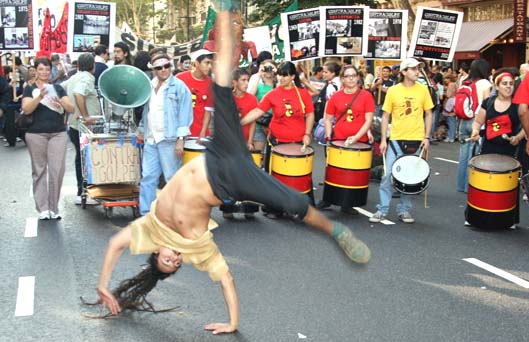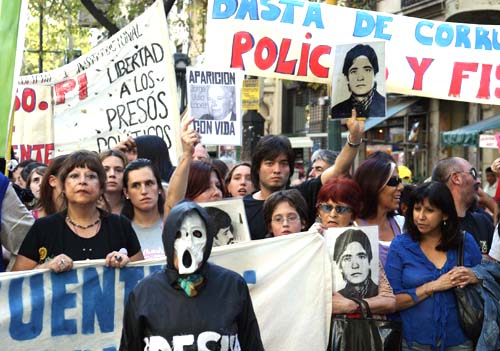Open wounds
In the offices of the Argentine Forensic Anthropology Team, Pedro Cerviño overlooks the remains of his sister who was kidnapped by the military in 1976. María Teresa Cerviño was murdered and buried in a cemetery in a Buenos Aires suburb. Cerviño and an anthropologist touch the bones laid out on a table as if they were transported 30 years into the past
The Anthropologist gives the gruesome details of María Teresa’s death. The hands and feet of the skeleton are missing. She says that it was common for the military to cut the hands off of the disappeared before burying them in unmarked graves in cemeteries. From the marks on the skull it is apparent that before her death she received several injuries to the head.
"With the disappearance there’s a perverse feeling of not knowing. Not knowing what happened, if the person is dead or alive," says Luis Fondebrinder. Luis Fondebrider has worked as a forensic anthropologist with the The Argentine Forensic Anthropology Team (EAAF) since its founding. The EAAF has identified the remains of 300 disappeared since 1984.

[Demonstrations marked the 32nd anniversary of the 1976 military coup. All photos: Marie Trigona]
The anthropologist says the identification of remains allows family members to have closure after 30 years of searching. "It’s a cultural and psychological need of having certainty. It also allows for family members to know their loved ones are dead and to recover the bodies and to hold funeral services depending on the religion and culture. It allows for them to close a period of so many years of pain and anguish."
Anthropological and forensic methods
In this past year the team identified 45 bodies. The team completes three stages to identify the remains of the disappeared. The most extensive is the preliminary research, the research of documents from the dictatorship and the state such as archives from cemeteries and intelligence reports carried out by the Argentine State. The second stage is a reconstruction of events based on interviews with family members and witnesses that allows the forensic anthropologist to develop a hypothesis of events and where the body may be buried. The final stage is the scientific field work in excavation sites.
Much of the team’s work has helped to reconstruct the historical void surrounding the Argentine military dictatorship’s organization and methods. In order to disappear 30,000 the military dictatorship organized an extensive network of clandestine detention centers and methods of terror. Human Rights groups have investigated the existence of 375 clandestine detention centers that operated throughout the South American nation.
The "Vuelos del Muerte" (Flights of Death) were the military dictatorship’s most common method of terror – drugging dissidents and dropping them from planes into the Atlantic Ocean. Many of the bodies have never been found, let alone identified. The Argentine military weren’t as careless as the Nazis, they did not regularly use mass graves to dispose of bodies, although they adopted the fascist ideologies and methods of mass extermination. To date, two mass graves have been discovered. When the disappeared were buried, their remains were put into unmarked graves in cemeteries.
Bringing back identity
Family members and fellow activists carry the remains of María Angelica Pinto Rubio to a cemetery in Buenos Aires. María Angelica Pinto Rubio was disappeared in 1977 at 21 years of age. Her sister Margarita reads a memorial letter at the funeral in 2007. "For 30 years the military wanted us to believe the families were responsible for our brothers’ and sisters’ disappearances. For 30 years they wanted to take away María Angelica’s identity, transforming her into a Jane Doe."

While choking back tears that carry 30 years of pain and longing, Margarita commemorates María Angelica along with Mothers of Plaza de Mayo and fellow activists. "Thanks to the struggle and the work of the Argentine Forensic Anthropology Team we were able to bring back a face, name and history of struggle for our dear María Angelica. Today we can say, María Angelica, disappeared social activist, disappeared for believing that our country had to be more just. We can say María Angelica you’re present now and forever."
Thanks to the work of the Argentine Forensic Anthropology Team relatives and fellow survivors can bring closure to a painful past. The team has allowed relatives and fellow activists to bring back the identity of the disappeared – every single one of the disappeared has a name, a history, commitment to social justice – each one of them gave their lives in the struggle for a better world.
Thirty two years of impunity
Thirty two years after Argentina’s bloody military junta human rights groups and relatives continue to demand justice for the crimes against humanity committed during the 1976-1983 military dictatorship. "The identification of the disappeared also gives objective evidence to the courts in the trials of those responsible for these crimes," says Fondebrinder.
Justice is now legally possible since the Supreme Court nullified the amnesty for military leaders through the full-stop and due-obedience laws passed in the 1990’s. Much of the evidence has been researched by human rights organizations, with very little support from the government. More than 200 former military personnel and members of the military government have been accused of human rights crimes and are now awaiting trial. However, groups worry that the trials are advancing at a snail’s pace.

Emi Dambra is the mother of two disappeared. She does not know where the remains of her son or daughter are located. According to Dambra, those responsible for leading the bloody military junta should be put behind bars. "We want to know what happened to each one of the victims, we want the people who organized this slaughter to be put in regular jails, with life sentences."
The EAAF has launched a national campaign for DNA testing of relatives of the disappeared to help in the identification of 600 unidentified skeletons the team has excavated from unmarked graves throughout the country. From preliminary investigations, the team believes the bodies belong to individuals disappeared by the military dictatorship.
To learn more about the work of The Argentine Forensic Anthropology Team visit http://www.eaaf.org/
Marie Trigona is a writer, radio producer and video maker based in Buenos Aires. She can be reached at [email protected] Her website is http://mujereslibres.blogspot.com/
